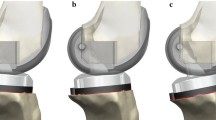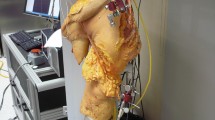Abstract
Purpose
The purpose of this study was to evaluate the relationship between posterior tibial slope and knee kinematics in bi-cruciate stabilized (BCS) total knee arthroplasty (TKA), which has not been previously reported.
Methods
This computer simulation study evaluated Journey 2 BCS components (Smith & Nephew, Inc., Memphis, TN, USA) implanted in a female patient to simulate weight-bearing stair climbing. Knee kinematics, patellofemoral contact forces, and quadriceps forces during stair climbing (from 86° to 6° of flexion) were computed in the simulation. Six different posterior tibial slope angles (0°–10°) were simulated to evaluate the effect of posterior tibial slope on knee kinematics and forces.
Results
At 65° of knee flexion, no anterior sliding of the tibial component occurred if the posterior tibial slope was less than 10°. Anterior contact between the anterior aspect of the tibial post- and the femoral component was observed if the posterior tibial slope was 6° or more. An increase of 10° in posterior tibial slope (relative to 0°) led to a 4.8% decrease in maximum patellofemoral contact force and a 1.2% decrease in maximum quadriceps force.
Conclusion
BCS TKA has a wide acceptable range of posterior tibial slope for avoiding knee instability if the posterior tibial slope is less than 10°. Surgeons should prioritize avoiding adverse effects over trying to achieve positive effects such as decreasing patellofemoral contact force and quadriceps force by increasing posterior tibial slope. Our study helps surgeons determine the optimal posterior tibial slope during surgery with BCS TKA; posterior tibial slope should not exceed 10° in routine clinical practice.








Similar content being viewed by others
Abbreviations
- TKA:
-
Total knee arthroplasty
- BCS:
-
Bi-cruciate stabilized
- PS:
-
Posterior-stabilized
- ACL:
-
Anterior cruciate ligament
- PCL:
-
Posterior cruciate ligaments
- AP:
-
Anteroposterior
- FE:
-
Finite element
- 2D:
-
2-Dimensional
- 3D:
-
3-Dimensional
- ICC:
-
Intraclass correlation coefficients
- PTS:
-
Posterior tibial slope
References
Barrett WP, Mason JB, Moskal JT, Dalury DF, Oliashirazi A, Fisher DA (2011) Comparison of radiographic alignment of imageless computer-assisted surgery vs conventional instrumentation in primary total knee arthroplasty. J Arthroplasty 26(8):1273–1284
Barrack RL, Schrader T, Bertot AJ, Wolfe MW, Myers L (2001) Component rotation and anterior knee pain after total knee arthroplasty. Clin Orthop Relat Res 392:46–55
Blankevoort L, Kuiper JH, Huiskes R, Grootenboer HJ (1991) Articular contact in a three-dimensional model of the knee. J Biomech 24(11):1019–1031
Colwell CW Jr, Chen PC, D’Lima D (2011) Extensor malalignment arising from femoral component malrotation in knee arthroplasty: effect of rotating–bearing. Clin Biomech (Bristol, Avon) 26(1):52–57
Dejour D, Saffarini M, Demey G, Baverel L (2015) Tibial slope correction combined with second revision ACL produces good knee stability and prevents graft rupture. Knee Surg Sports Traumatol Arthrosc 23:2846–2852
Dennis DA, Komistek RD, Mahfouz MR (2003) In vivo fluoroscopic analysis of fixed-bearing total knee replacements. Clin Orthop Relat Res 410:114–130
D’Lima DD, Poole C, Chadha H, Hermida JC, Mahar A, Colwell CW Jr (2001) Quadriceps moment arm and quadriceps forces after total knee arthroplasty. Clin Orthop Relat Res 392:213–220
Hamai S, Miura H, Higaki H, Matsuda S, Shimoto T, Sasaki K, Yoshizumi M, Okazaki K, Tsukamoto N, Iwamoto Y (2008) Kinematic analysis of kneeling in cruciate-retaining and posterior-stabilized total knee arthroplasties. J Orthop Res 26(4):435–442
Hamai S, Okazaki K, Shimoto T, Nakahara H, Higaki H, Iwamoto Y (2015) Continuous sagittal radiological evaluation of stair-climbing in cruciate-retaining and posterior-stabilized total knee arthroplasties using image-matching techniques. J Arthroplasty 30(5):864–869
Kim YH, Park JW, Kim JS, Park SD (2014) The relationship between the survival of total knee arthroplasty and postoperative coronal, sagittal and rotational alignment of knee prosthesis. Int Orthop 38:379–385
Kuroyanagi Y, Mu S, Hamai S, Robb WJ, Banks SA (2012) In vivo knee kinematics during stair and deep flexion activities in patients with bicruciate substituting total knee arthroplasty. J Arthroplasty 27(1):122–128
Kuwashima U, Hamai S, Okazaki K, Ikebe S, Higaki H, Mizu-Uchi H, Akasaki Y, Murakami K, Iwamoto Y (2016) Contact stress analysis of the anterior tibial post in bi-cruciate stabilized and mobile-bearing posterior stabilized total knee arthroplasty designs. J Mech Behav Biomed Mater 60:460–467
Li G, Papannagari R, Most E, Park SE, Johnson T, Tanamal L, Rubash HE (2005) Anterior tibial post impingement in a posterior stabilized total knee arthroplasty. J Orthop Res 23(3):536–541
Matsuda S, Kawahara S, Okazaki K, Tashiro Y, Iwamoto Y (2013) Postoperative alignment and ROM affect patient satisfaction after TKA. Clin Orthop Relat Res 471(1):127–133
Mihalko WM, Conner DJ, Benner R, Williams JL (2012) How does TKA kinematics vary with transverse plane alignment changes in a contemporary implant? Clin Orthop Relat Res 470(1):186–192
Mizu-uchi H, Colwell CW Jr, Matsuda S, Flores-Hernandez C, Iwamoto Y, D’Lima DD (2011) Effect of total knee arthroplasty implant position on flexion angle before implant-bone impingement. J Arthroplasty 26(5):721–727
Mizu-Uchi H, Colwell CW Jr, Fukagawa S, Matsuda S, Iwamoto Y, D’Lima DD (2012) The importance of bony impingement in restricting flexion after total knee arthroplasty: computer simulation model with clinical correlation. J Arthroplasty 27(9):1710–1716
Morra EA, Heim CS, Greenwald AS (2012) Preclinical computational models: predictors of tibial insert damage patterns in total knee arthroplasty: AAOS exhibit selection. J Bone Surg Am 94(18):e137(1–5)
Okamoto S, Mizu-uchi H, Okazaki K, Hamai S, Nakahara H, Iwamoto Y (2015) Effect of tibial posterior slope on knee kinematics, quadriceps force, and patellofemoral contact force after posterior-stabilized total knee arthroplasty. J Arthroplasty 30(8):1439–1943
Ostermeier S, Hurschler C, Windhagen H, Stukenborg-Colsman C (2006) In vitro investigation of the influence of tibial slope on quadriceps extension force after total knee arthroplasty. Knee Surg Sports Traumatol Arthrosc 14(10):934–939
Sessa P, Fioravanti G, Giannicola G, Cinotti G (2015) The risk of sacrificing the PCL in cruciate retaining total knee arthroplasty and the relationship to the sagittal inclination of the tibial plateau. Knee 22:51–55
Shi X, Shen B, Kang P, Yang J, Zhou Z, Pei F (2013) The effect of posterior tibial slope on knee flexion in posterior-stabilized total knee arthroplasty. Knee Surg Sports Traumatol Arthrosc 21(12):2696–2703
Tanaka Y, Nakamura S, Kuriyama S, Ito H, Furu M, Komistek RD, Matsuda S (2016) How exactly can computer simulation predict the kinematics and contact status after TKA? Examination in individualized models. Clin Biomech (Bristol, Avon) 39:65–70
Victor J, Mueller JK, Komistek RD, Sharma A, Nadaud MC, Bellemans J (2010) In vivo kinematics after a cruciate- substituting TKA. Clin Orthop Relat Res 468(3):807–814
Wachowski MM, Walde TA, Balcarek P, Schüttrumpf JP, Frosch S, Stauffenberg C, Frosch KH, Fiedler C, Fanghänel J, Kubein-Meesenburg D, Nägerl H (2012) Total knee replacement with natural rollback. Ann Anat 194(2):195–199
Walter SD, Eliasziw M, Donner A (1998) Sample size and optimal designs for reliability studies. Stat Med 17(1):101–110
Wasielewski RC, Galante JO, Leighty RM, Natarajan RN, Rosenberg AG (1994) Wear patterns on retrieved polyethylene tibial inserts and their relationship to technical considerations during total knee arthroplasty. Clin Orthop Relat Res 299:31–43
Zeng C, Yang T, Wu S, Gao SG, Li H, Deng ZH, Zhang Y, Lei GH (2016) Is posterior tibial slope associated with noncontact anterior cruciate ligament injury. Knee Surg Sports Traumatol Arthrosc 24:830–837
Acknowledgements
We would like to thank Y. Wang and H. Higaki, Faculty of Engineering, Kyusyu Sangyo University, Fukuoka, Japan, for the help in analysing the data.
Author information
Authors and Affiliations
Contributions
MH collected and analysed the data and drafted the manuscript. HM conceived of the study, participated in its design, collected and analysed the data and coordination and helped to draft the manuscript. HM is also the corresponding author. KO collected and analysed the data and assisted in drafting the manuscript. TK, KM, and YM collected and analysed the data. SH assisted in drafting the manuscript. YN gave final approval to the manuscript.
Corresponding author
Ethics declarations
Conflict of interest
Hideki Mizu-uchi: Zimmer Biomet; Paid presenter or speaker. Ken Okazaki: Zimmer Biomet; Paid presenter or speaker. Smith & Nephew; Paid presenter or speaker. Johnson & Johnson; Paid presenter or speaker. Pfizer Inc.; Research support. Cyfuse Inc.; Research support. The authors declare that they have no conflict of interest concerning this study.
Funding
No funds were received in support of this study.
Ethical approval
This study was approved by the institutional review board of Kyushu University (No. 25–74).
Informed consent
Informed consent was obtained from all patients prior to study participation.
Rights and permissions
About this article
Cite this article
Hada, M., Mizu-uchi, H., Okazaki, K. et al. Bi-cruciate stabilized total knee arthroplasty can reduce the risk of knee instability associated with posterior tibial slope. Knee Surg Sports Traumatol Arthrosc 26, 1709–1716 (2018). https://doi.org/10.1007/s00167-017-4718-0
Received:
Accepted:
Published:
Issue Date:
DOI: https://doi.org/10.1007/s00167-017-4718-0




